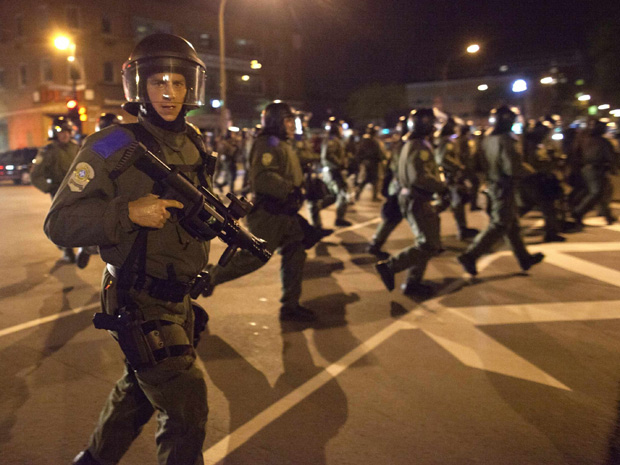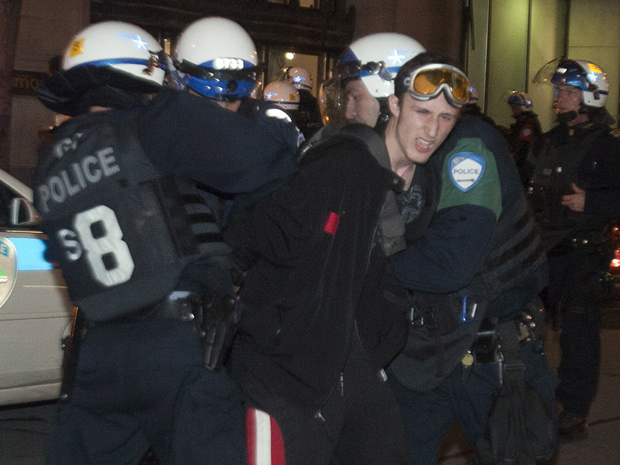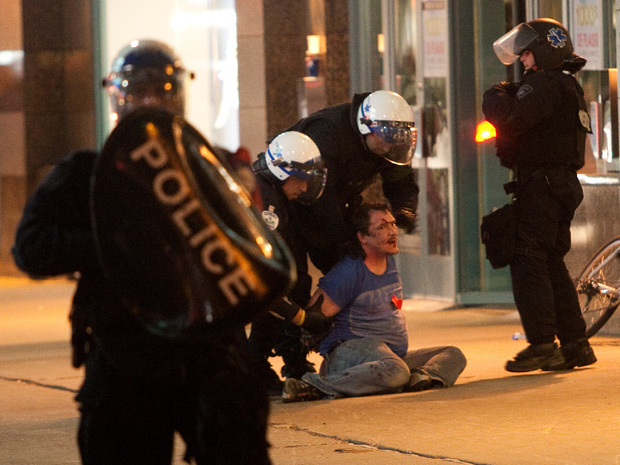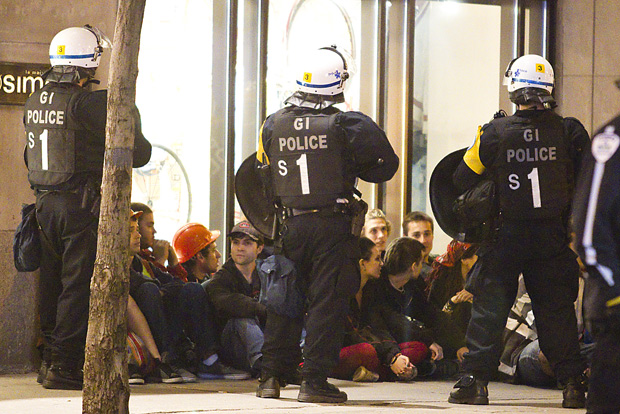
By the end of a cat-and-mouse operation that marked the fourth straight night of clashes, police spokesman Simon Delorme said that at least 100 people had been arrested and two police officers had been injured.
Four other people were taken to hospital but the extent of their injuries was not immediately known.
It is believed to be the first time Bill 78 and the city's new anti-mask bylaw were used by police although Sherbrooke police used the provincial law on Monday to round up 36 protesters in that city.
While the atmosphere during the day in Montreal was almost carnival-like, the mood in the evening soon turned as dark as the night that enveloped the march.
Projectiles were thrown at police and gusts of pepper spray tinged the air as riot equipped police sent people scattering.

On trendy St-Denis Street, one demonstrator tried to set a trash can on fire using a paper cup, but another student knocked the flaming container onto the ground and stomped it out.
Police were also called in to investigate an altercation between a frustrated motorist and two pedestrians near the demonstration, one of whom was treated for minor injuries in hospital. Police said the car had made contact with one pedestrian.
One of the tactics of the nighttime marches has been to walk against the flow of traffic, which often gets honks of support but sometimes brings scowls.
Police declared the evening march - the 29th of its kind since the protest started 100 days ago - illegal when some projectiles flew through the air at them. And they invoked the controversial Bill 78 and a Montreal bylaw that forbids masks during public protests.
"They didn't share the route, demonstrators were wearing masks and projectiles were thrown at police officers," the Montreal police said on their Twitter feed, which was rapidly updated as the night progressed.
To that point, the march had been largely peaceful although more radical elements, some identified as members of the hardcore anti-capitalist Black Bloc movement, were seen slipping through the demonstration with their prominent black flag flapping in the warm night air.
Police did not immediately use the controversial laws after they were passed last week, saying they were still figuring out how to apply them. So far, they had allowed the demonstrations to proceed if they stayed peaceful.

As well, the powerful Montreal transit union also gave protesters a boost when it called on its members to avoid driving police squads around on city buses during the crowd control operations. Montreal police have for several years used city buses as well as their cruisers to shuttle riot squad officers around to demonstration hotspots and as places to detain prisoners.
The nighttime march snaked through several Montreal neighbourhoods after it kicked off from Parc Emilie-Gamelin, a spot where all the night marches begin and which is named for a beatified nun who gave comfort to condemned rebels in the 1837 Lower Canada Rebellion.
The chanting march had not gone far before pyrotechnical devices were thrown and were followed near the downtown core by beer bottles. Police flooded Ste-Catherine Street, the city's commercial core where chain stores sit side-by-side with upscale boutiques and told everyone to get off the streets or face arrest for participating in a riot.
As the lines of police formed up to sweep the area, one nervous-looking passerby wearing a red hoodie - the colour adopted by the protest movement - mumbled, "I think I'm wearing the wrong colour tonight" as he scurried away from the street which shortly resembled a ghost town.
The daytime march was considered to be one of the biggest protests held in the city and related events were held in New York, Paris, Toronto, Calgary and Vancouver.
Although fewer than one-third of Quebec's college and university students are boycotting classes, they have galvanized anger against the provincial government to the point that it tried to defend its new law by saying there were other places with tougher legislation.
The provincial law, which sets strict rules for protests and imposes heavy fines for violators and their supporters, has drawn wide condemnation and a call from the Parti Quebecois to hold an election on the issue.
Gabriel Nadeau-Dubois, co-spokesman for the hardline CLASSE group, described Tuesday's march as a historic act of civil disobedience and said he was ready to face any legal consequences.
"So personally I will be ready to face justice, if I need to."
Source: The Canadian Press




Reader Comments
to our Newsletter